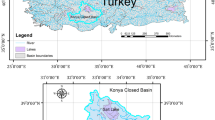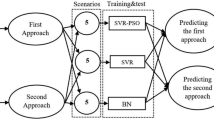Abstract
Sand production by soil erosion in small watershed is a complex physical process. There are few physical models suitable to describe the characteristics of the intense erosion in domestic loess plateau. Introducing support vector machine (SVM) oriented to small sample data and possessing good extension property can be an effective approach to predict soil erosion because SVM has been applied in hydrological prediction to some extent. But there are no effective methods to select the rational parameters for SVM, which seriously limited the practical application of SVM. This paper explored the application of intelligence-based particle swarm optimization (PSO) algorithm in automatic selection of parameters for SVM, and proposed a prediction model by linking PSO and SVM for small sample data analysis. This method utilized the high efficiency optimization property and swarm paralleling property of PSO algorithm and the relatively strong learning and extending capacity of SVM. For an example of Huangfuchuan small watershed, its intensive fragmentation and intense erosion earn itself the name of “worst erosion in the world”. Using four characteristics selection algorithms of correlation feature selection, the primary affecting factors for soil erosion in this small watershed were determined to be the channel density, ravine area, sand rock proportion, and the total vegetation coverage. Based on the proposed PSO–SVM algorithm, the soil erosion modulus in the small watershed was predicted. The accuracy of the simulation and prediction was good, and the average error was 3.85%. The SVM predicting model was based on the monitoring data of sand production. The construction of the SVM erosion modulus prediction model for the small watershed comprehensively reflected the complex mechanism of soil erosion and sand production. It had certain advantage and relatively high practical value in small sample prediction in the discipline of soil erosion.




Similar content being viewed by others
References
Baffalt C, Nearing MA, Nicks AD (1996) Impact of GLIGEN parameters on WEPP predicted average soil loss. Trans ASAE 39(2):1001–1020
Cai QG, Liu JG (2003) Evolution of soil erosion models in China. Prog Geo 22(3):230–242
Cai QG, Wang GP, Chen YZ (1998) Process and simulation of soil erosion in Loess Plateau watershed. Science Press, Beijing, pp 108–110 (in Chinese)
Cheng LH, Jian FD (2008) A distributed PSO–SVM hybrid system with feature selection and parameter optimization. Appl Soft Comput 8:1381–1391
De Roo APJ (1996) The LISEM project: an introduction. Hydrol Process 10:1021–1025
Deng NY, Tian YJ (2004) New method in data mining-SVM. Science Press, Beijing, pp 214–218
Fan RY (1985) Study on the calculating the soil erosion quantity of watershed in the middle of Yellow River. Sci Water Soil Conserv 2:12–18 (in Chinese with English abstract)
Flanagan DC (2001) WEPP CD-ROM
Fu BJ, Chen LD, Qiu Y, Wang J, Meng QH (2002) Land use structure and ecological process in the loess hilly-gully region. Commerce Press, Beijing, p 24
Jiang ZS, Wang ZQ, Liu Z (1996) Quantificational study on the space variety of soil erosion in the Loess hill area. J Soil Eros Soil Water Conserv 2(1):1–9 (in Chinese with English abstract)
Jin ZP, Zhao HX, He T, Zhao HX (1991) An approach to the equation predicting soil erosion of small watershed in Huangfuchuan area. J Soil Water Conserv 5(1):8–18 (in Chinese with English abstract)
Li YK, Yang PL, Tian YJ, Ren SM, Zhao HX (2007) Application of support vector regression method in predicting soil erosion intensity of small watershed in the insensitive erosion areas. J Beijing For Univ 29(3):93–98 (in Chinese with English abstract)
Liu BY, Zhang KL, Xie Y (2002) An empirical soil loss equation/process of soil erosion and its environment effect, vol II 12th ISCO. Tsinghua Press, Beijing, pp 21–25
Mark AH (2000) Correlation-based feature selection for discrete and numeric class machine learning. In: Proceedings of seventeenth international conference on machine learning. Morgan Kaufmann Publishers Inc., Menlo Park, pp 359–366
Morgan RPC, Quinton JN, Smith RE, Smith RE, Govers G, Poesen JWA, Auerswald K, Chisci G, Torri D, Styczen M E (1998) The European soil erosion model (EUROSEM): a dynamic approach for predicting sediment transport from fields and small catchments. Earth Surf Process Landf 23:527–544
Ni JP, Xie CY, Wei CF, Xie DT (2005) Recent development of predictive model of soil erosion. Sci Water Soil Conserv 3(1):66–71 (in Chinese with English abstract)
Renard KG, Foster GR, Weesies GA, McCool DK, Yoder DC (1997) RUSLE a guide to conservation planning with the revised universal soil loss equation. USDA Agricultural Handbook no. 703
Sheng FY, Fu LC (2007) Fault diagnostics based on particle swarm optimization and support vector machines. Mech Syst Signal Process 21:1787–1798
Sun LD, Sun BP, Chen Y (1988) The predicting equation of soil erosion quantity of Loess hill ravine area watershed in XiJi County. Trans Nat Res 3(2):141–153 (in Chinese with English abstract)
Tan LQ, Chen GX, Cai MY (1990) Mathematical modeling of soil erosion in the Loess hill area. J HEHAI Univ 18(6):10–16 (in Chinese with English abstract)
Tang ZH, Cai QG (2002) Review on the studies of Chinese main soil erosion and sediment yield models. J Mt Sci 20(4):466–475 (in Chinese with English abstract)
Wang ZL, Huang XH, Niu ZH (2004) Review of models of soil erosion and sediment yield in catchments in China. Res Soil Water Conserv 11(4):28–33 (in Chinese with English abstract)
Wei CH (2008) Rainfall forecasting by technological machine learning models. Appl Math Comput 200:41–57
Wischmeier WH, Smith DD (1978) Predicting rain fall erosion losses. USDA Agricultural Handbook no. 537
Xiong WL, Xu BG (2006) Study on optimization of SVR parameters selection based on PSO. J Syst Simul 18(9):2442–2445 (in Chinese with English abstract)
Xu JH, Lv GD, Zhang SL (2000) The region delineation and principle of sand supply in middle reaches of Yellow River. Yellow River Press, Zhengzhou, 215 pp
Yin GK, Chen QL (1989) The characteristic index and statistical pattern of soil erosion in Loess Plateau watershed. Trans Geo 44(1):32–46 (in Chinese with English abstract)
Zhao HX (1998) Reconsideration on the soil erosion laws in HuangFuchuan watershed—application of soil erosion estimation models for small watersheds. Res Soil Water Conserv 5(3):101–105
Acknowledgments
We are grateful for financial support by the Program for Changjiang Scholars and Innovative Research Team in University (PCSIRT) (No.IRT0657), National Basic Research Program of PR China (973 Project, 2009CB421100), the National Natural, Science Foundation for Innovation Team of China (No. 40701189), “11th Five-year” National Key Project for S&T of China (2006BAC01A01) and the Science Fund of China Postdoctor (No.20080430072).
Author information
Authors and Affiliations
Corresponding authors
Additional information
Li Yunkai, Tian Yingjie, Ouyang Zhiyun and Wang Lingyan are equally contributed to this paper.
Rights and permissions
About this article
Cite this article
Yunkai, L., Yingjie, T., Zhiyun, O. et al. Analysis of soil erosion characteristics in small watersheds with particle swarm optimization, support vector machine, and artificial neuronal networks. Environ Earth Sci 60, 1559–1568 (2010). https://doi.org/10.1007/s12665-009-0292-1
Received:
Accepted:
Published:
Issue Date:
DOI: https://doi.org/10.1007/s12665-009-0292-1




